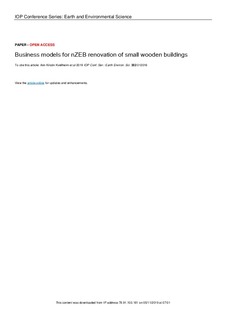| dc.contributor.author | Kvellheim, Ann Kristin | |
| dc.contributor.author | Damman, Sigrid | |
| dc.contributor.author | Lien, Anne Gunnarshaug | |
| dc.date.accessioned | 2019-11-05T15:50:09Z | |
| dc.date.available | 2019-11-05T15:50:09Z | |
| dc.date.created | 2019-11-05T08:03:41Z | |
| dc.date.issued | 2019 | |
| dc.identifier.issn | 1755-1307 | |
| dc.identifier.uri | http://hdl.handle.net/11250/2626731 | |
| dc.description.abstract | To achieve a sustainable building stock, it is necessary to focus on existing as well as new buildings. New houses built according to the Norwegian building code are close to nZEB (near Zero-Energy Building) level, but existing buildings contribute a significant share of the energy consumption, and the difference between new and older houses is increasing. As the renovation rate is low, it is important to include ambitious energy upgrading once a renovation project is undertaken. So far, however, there is almost no market for nZEB renovation of small wooden buildings. These buildings are challenging to renovate, and even more challenging to do so with ambitious climate targets. In effect, only half of the renovations in Norway include energy renovation. The demand for ambitious renovation depends on a value proposition that is understood by the customer. Novel and well-designed business models can be central tools for achieving this. In this paper, existing and potential business models for renovation of wooden housing are identified and analysed.
This paper is based on the “Energy upgrading of wooden dwellings to nearly zero energy level” (OPPTRE) project. One of the activities for researchers, industry and public partners in OPPTRE is to identify, analyse and assess current business models, and develop novel approaches through collaborative workshops and interviews. The results are documented and elaborated upon by the research team before the next step, which is to test the most promising models.
Previous research indicates that only a small share of Norwegian enterprises have changed their business model over time. Two of the reasons for this are lack of critical reflection on existing business models and fear of changing the status quo. A third reason is lack of knowledge of how to manage the transformation process. In the process of identifying existing and developing novel business models, the partners in OPPTRE explore new opportunities to promote ambitious energy upgrading. Their commercial performance is likely to increase through the focus on business model design. New business models may also help increase the uptake of innovative energy solutions in the renovation market for small wooden buildings. | nb_NO |
| dc.language.iso | eng | nb_NO |
| dc.publisher | IOP Conference Science | nb_NO |
| dc.relation.ispartofseries | 1st Nordic conference on Zero Emission and Plus Energy Buildings | |
| dc.rights | CC BY 3.0 | |
| dc.rights.uri | https://creativecommons.org/licenses/by/3.0/ | |
| dc.title | Business models for nZEB renovation of small wooden buildings | nb_NO |
| dc.type | Conference object | nb_NO |
| dc.type | Journal article | nb_NO |
| dc.type | Peer reviewed | nb_NO |
| dc.description.version | publishedVersion | nb_NO |
| dc.rights.holder | © The authors | nb_NO |
| dc.subject.nsi | VDP::Teknologi: 500 | nb_NO |
| dc.source.volume | 352 | nb_NO |
| dc.source.journal | IOP Conference Series: Earth and Environmental Science (EES) | nb_NO |
| dc.identifier.doi | 10.1088/1755-1315/352/1/012018 | |
| dc.identifier.cristin | 1744005 | |
| dc.relation.project | Norges forskningsråd: 280956 | nb_NO |
| dc.source.articlenumber | 012018 | |
| cristin.unitcode | 7401,30,40,0 | |
| cristin.unitcode | 7401,90,30,0 | |
| cristin.unitname | Arkitektur, byggematerialer og konstruksjoner | |
| cristin.unitname | Teknologiledelse | |
| cristin.ispublished | true | |
| cristin.fulltext | original | |
| cristin.qualitycode | 1 | |

